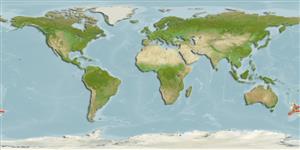Common names from other countries
Environment: milieu / climate zone / depth range / distribution range
Ekologi
; kisaran kedalaman 140 - 640 m (Ref. 4). Temperate; 6°C - 14°C (Ref. 128678), preferred 14°C (Ref. 107945); 33°S - 48°S, 166°E - 173°W (Ref. 4)
Indo-west Pacific: New Zealand and Kermadec Island.
Length at first maturity / Size / Weight / umur
Maturity: Lm 3.4 range ? - ? cm Max length : 25.0 cm TL jantan/; (Ref. 4); common length : 15.5 cm TL jantan/; (Ref. 4)
It has a total body length of 25 cm, mostly between 13 and 18 cm (Ref. 4). Prefers mud or sandy mud substrates that are firm enough for burrowing (Refs. 4, 106910) (Ref. 4).
Members of the order Decapoda are mostly gonochoric. Mating behavior: Precopulatory courtship ritual is common (through olfactory and tactile cues); usually indirect sperm transfer.
rujukan utama
Acuan | Koordinator | mitra
Holthuis, L.B. 1991. (Ref. 4)
Status IUCN Red List (Ref. 130435)
status CITES (Ref. 108899)
Not Evaluated
Not Evaluated
penggunaan manusia
Perikanan: komersial
FAO - Perikanan: landings | FishSource | Sea Around Us
Alat, peralatan
informasi lanjut
Umur / Saiz
Pertumbuhan
panjang-berat
panjang-panjang
Morfologi
Larva
Kelimpahan
Sumber internet
Estimates based on models
Preferred temperature
(Ref.
115969): 8.6 - 13.4, mean 10.9 (based on 30 cells).
